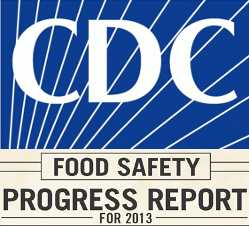 l number of illnesses caused by pathogens commonly transmitted by food remained unchanged in 2013 when compared to 2006 statistics reported by the Centers for Disease Control and Prevention.
l number of illnesses caused by pathogens commonly transmitted by food remained unchanged in 2013 when compared to 2006 statistics reported by the Centers for Disease Control and Prevention.The CDC’s Food Safety Report Card for 2013 did, however, show a 9% decrease in salmonella infections, based on statistics collected from 10 sites that include about 15% of the U.S. population, about 48 million people.
The statistics do not break out numbers based on foodborne-only routes of infection and do not include any specifics related to fresh produce.
For 2013, the 10 sites included in the Foodborne Diseases Active Surveillance Network (FoodNet) reported a total of 19,056 infections resulting in 4,200 hospitalizations and 80 deaths, according to the CDC report. Infections from all of the pathogens tracked continue to be above the target frequencies established by the CDC.
“The lack of recent progress toward these targets points to gaps in the current food safety system and the need for more food safety interventions,” according to the CDC report.
“Most foodborne illnesses can be prevented, and progress has been made in decreasing contamination of some foods and reducing illness caused by some pathogens since 1996, when FoodNet began. More can be done; surveillance data provide information on where to target prevention efforts,” according to the report.
Infection rates for the pathogens tracked by FoodNet for 2013 compared to numbers from 2010-12 are:
- Listeria, down 3%
- Salmonella, down 9%
- Campylobacter, up 2%
- E. coli non-0157, up 8%
- E. coli 0157, up 16%
- Vibrio, up 32%
- Yersinia, up 7%
“The latest information from FoodNet highlights the importance of continuing preventive measures from the farm to the consumer,” Stephen Ostroff, acting chief scientist at the Food and Drug Administration, said in a news release.
“We are making significant progress in implementing the Food Safety Modernization Act, having issued seven proposed rules addressing the safety of produce, imported foods, and human and animal food production and transportation. Full implementation of these rules will help prevent these types of infections,” according to the FDA release.





